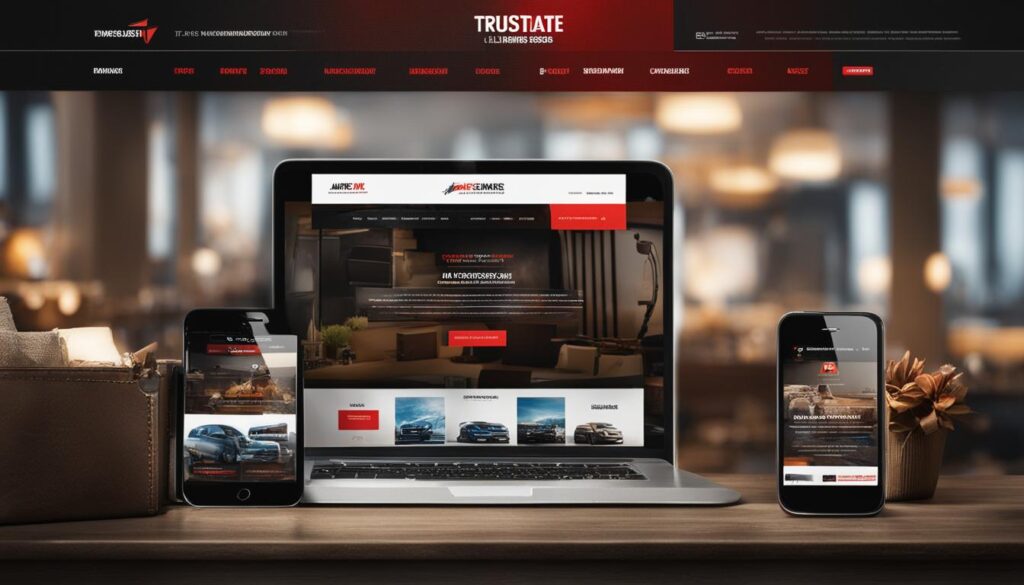Affiliate marketing is a powerful strategy in the world of online marketing, allowing individuals to earn commissions by promoting other people’s products or services. To succeed in this competitive field, it’s crucial to create high-converting affiliate landing pages that drive your audience to take action. In this article, we will uncover the secrets behind creating landing pages that maximize conversions and boost your affiliate success.
Key Takeaways:
- Understanding your target audience is essential for crafting high-converting landing pages.
- Compelling headlines and persuasive copy can greatly influence conversion rates.
- Well-designed landing pages, optimized for mobile, can significantly improve your chances of success.
- Social proof, trust signals, and clear calls-to-action build trust and entice visitors to take action.
- A/B testing and continuous optimization are vital for maximizing conversions over time.
Role of Affiliate Landing Pages in the Sales Funnel
Affiliate landing pages play a crucial role in guiding visitors through the various stages of the sales funnel, from awareness to action. These strategically designed pages serve as the bridge between potential customers and the desired outcome. To effectively move visitors along the sales funnel, it is essential to understand the target audience and craft a compelling message that resonates with their needs and desires.
The Sales Funnel Journey
The sales funnel consists of four key stages: awareness, interest, decision, and action. With the help of affiliate landing pages, you can guide your audience through each stage to ultimately drive conversions.
- Awareness: At this stage, visitors become aware of a problem or need they have. Affiliate landing pages can capture their attention and introduce them to a relevant solution. This is where the importance of impactful headlines and compelling copy comes into play.
- Interest: Once visitors are aware of the solution, they want to learn more. By highlighting the benefits and unique selling points of the product or service on the landing page, you can pique their interest and keep them engaged.
- Decision: Before taking any action, potential customers need to be convinced that the product or service will meet their needs. Including testimonials, case studies, and social proof on your landing page can help build trust and alleviate any doubts they may have.
- Action: This is the final stage where visitors are ready to take the desired action, whether it’s making a purchase, signing up for a newsletter, or filling out a form. A clear and compelling call-to-action (CTA) is crucial to encourage visitors to convert.
In the words of American author Alan Lakein, “Failing to plan is planning to fail.” This holds true for affiliate landing pages as well. A well-thought-out strategy that aligns with each stage of the sales funnel can significantly increase your chances of converting visitors into customers.
Sample Sales Funnel Journey
| Stage | Description |
|---|---|
| Awareness | Visitors become aware of their problem or need. |
| Interest | Visitors learn more about the product or service and become interested. |
| Decision | Visitors evaluate the product or service and decide whether to purchase. |
| Action | Visitors take the desired action, such as making a purchase or signing up. |
Creating affiliate landing pages that effectively guide visitors through the sales funnel is a skill that can greatly impact your affiliate marketing success. By understanding your target audience, crafting compelling messaging, and utilizing persuasive design elements, you can maximize conversions and achieve your affiliate marketing goals.
Continue reading to discover the secrets behind crafting compelling headlines and copy for your landing pages in Section 3.
Crafting Compelling Headlines and Copy for the Landing Pages
The headline and copy on landing pages play a critical role in driving conversions. When crafting your headlines and copy, it is essential to focus on creating compelling, persuasive content that effectively communicates your value proposition and convinces visitors to take action. Here are some key strategies to consider:
Create Benefit-Driven Headlines
When it comes to headlines, it’s crucial to highlight the benefits and value your offer provides. Use language that speaks directly to your target audience’s pain points or desires. Craft headlines that clearly convey the unique selling points and advantages of your product or service. For example:
Transform Your Skin with Our Revolutionary Anti-Aging Serum!
Use Powerful and Specific Language
To grab visitors’ attention, choose powerful words that evoke emotion and curiosity. Be specific and precise in your messaging to create a sense of urgency or exclusivity. Consider the following example:
Get 50% Off on All Orders Today Only!
Keep the Copy Concise
Visitors often scan landing pages, so it’s essential to keep your copy concise and easy to digest. Use short paragraphs, bullet points, and subheadings to break up the content and make it more scannable. Focus on highlighting the most important information and benefits of your offering.
Optimize with A/B Testing
A/B testing is a powerful tool that allows you to optimize your headlines and copy for maximum conversions. Create different variations of your headlines and copy, and test them against each other to see which performs better. Continuously analyze and refine your content based on the test results to improve conversion rates.

By applying these strategies, you can create landing pages with compelling headlines and persuasive copy that drive conversions. Remember to focus on communicating your value proposition, using powerful language, and optimizing through A/B testing to continuously improve your landing page performance.
Designing Landing Pages That Convert
When it comes to designing landing pages, the visual appeal and mobile optimization can significantly impact your conversion rates. A well-designed landing page not only captures the attention of your visitors but also guides them towards taking the desired action. To create a landing page that converts, consider the following key elements:
- Simplicity: Keep the design simple and clutter-free. A clean layout ensures that visitors can easily navigate your page and focus on the content that matters most.
- Visual Appeal: Utilize high-quality images and videos that showcase your product or service. Visual elements play a crucial role in capturing visitors’ attention and creating a sense of credibility and trust.
- Mobile Optimization: With the majority of internet users accessing websites through their mobile devices, it’s essential to optimize your landing page for mobile responsiveness. Ensure that your page displays correctly and provides a seamless user experience across various mobile devices.
Moreover, white space can be strategically used to create a sense of balance and guide visitors’ focus towards the most important elements. Clear calls-to-action are also crucial for driving conversions. The CTA should stand out on the page and be visually appealing to entice visitors to take action.

As emphasized by Nielsen Norman Group, “users often leave web pages in 10–20 seconds.” Therefore, your landing page design must make a strong first impression and provide a seamless user experience that keeps visitors engaged. Remember, a visually appealing, well-optimized landing page can significantly increase your conversion rates and maximize the success of your affiliate marketing efforts.
Using Social Proof, Trust Signals, & CTAs on Landing Pages
Social proof, trust signals, and clear calls-to-action (CTAs) are essential elements for building trust and increasing conversions on your landing pages. By incorporating these strategies, you can create a persuasive environment that encourages visitors to take action. Let’s explore how to effectively use social proof, trust signals, and CTAs to maximize conversions.
Social Proof: Testimonials, Reviews, and Case Studies
Social proof plays a vital role in establishing trust and credibility with your audience. Incorporating testimonials, reviews, and case studies provides evidence that your product or service delivers on its promises. Highlight positive feedback and real-life success stories to showcase the value and benefits you offer.
“[Your product] completely transformed my business. I saw a 200% increase in conversions within the first month!” – Sarah Johnson, Happy Customer
By including social proof on your landing pages, you create a sense of confidence and reliability, turning hesitant visitors into engaged customers.
Trust Signals: Security Badges and Money-Back Guarantees
Trust signals are visual cues that instill trust and confidence in your visitors. Security badges, such as SSL certifications, communicate that their personal information is safe and protected. Money-back guarantees demonstrate your commitment to customer satisfaction and reassure potential buyers that they can confidently make a purchase without risk.
Include trust signals prominently on your landing pages to alleviate any concerns and objections visitors may have, ultimately boosting conversions.
Clear and Action-Oriented CTAs
A compelling call-to-action (CTA) is the final nudge that motivates visitors to take the desired action, whether it’s signing up for a newsletter, making a purchase, or requesting more information. Your CTAs should be clear, concise, and visually distinct. Use action verbs and create a sense of urgency to prompt immediate action.
For example, a CTA stating “Start your free trial today and unlock exclusive benefits!” is more persuasive than a generic “Click here.” Engage your visitors with compelling CTAs that leave no room for ambiguity or indecision.
Remember, effective CTAs are crucial in guiding your visitors towards the conversion path, maximizing the chances of turning them into loyal customers.
A/B Testing & Optimizing for Maximum Conversions
When it comes to creating high-converting affiliate landing pages, A/B testing and optimization are crucial for achieving maximum conversions. A/B testing involves creating two versions of a landing page and comparing their performance to identify the most effective elements. By testing different headlines, copy, and call-to-action (CTA) buttons, you can gain valuable insights into what resonates with your audience and drives conversions.
A successful A/B testing strategy requires a systematic approach. Start by defining a clear hypothesis and selecting specific elements to test. These elements can include variations in headline wording, different placement of CTAs, or even changes in color schemes. By keeping your tests focused and structured, you’ll be able to draw meaningful conclusions from the results.
Once you’ve launched your A/B tests, closely monitor the data and metrics to evaluate the performance of each variation. Look for patterns and trends in conversion rates, click-through rates, and bounce rates. Analyzing this data will provide insights into which version of your landing page is performing better.
Remember that A/B testing is an ongoing process. Continuously iterate and optimize your landing page based on the insights gained from the tests. Implement the changes that have proven to increase conversion rates, and be open to experimenting with new variations to further improve your results.
Optimizing Headlines
One of the key elements to test and optimize in your landing page is the headline. A compelling and attention-grabbing headline plays a vital role in capturing visitors’ interest and motivating them to take action. Consider testing different variations of headlines that convey the value proposition and address the specific pain points of your target audience.
“By testing and optimizing headlines, you can enhance the effectiveness of your landing page in capturing visitors’ attention and driving conversions.”
Refining Copy and CTAs
In addition to headlines, the copy and CTAs on your landing page also have a significant impact on conversion rates. Test different variations of the copy, focusing on the clarity and persuasiveness of the messaging. Experiment with the placement and design of your CTAs to find the optimal combination that compels visitors to take action.
“Through careful testing and optimization, you can refine your landing page copy and CTAs to maximize their persuasive impact and drive conversions.”
Visual appeal and proper optimization are crucial elements in creating high-converting landing pages. By utilizing A/B testing and continuously optimizing your landing page, you can enhance its performance and increase your conversion rates. Remember to test specific elements such as headlines, copy, and CTAs, and use the insights gained to refine your landing page and maximize its conversion potential.
Conclusion
Designing high-converting landing pages is crucial for achieving success in affiliate marketing. By understanding your target audience and crafting compelling headlines and copy, you can capture their attention and persuade them to take action. The effective use of social proof and trust signals further builds trust and credibility, increasing conversions on your landing pages.
Additionally, the design of your landing pages plays a significant role in maximizing conversions. Creating visually appealing pages that are optimized for mobile devices ensures a seamless user experience. By incorporating high-quality images, videos, and strategically placed white space, you can enhance the overall aesthetic and engagement of your landing pages.
However, it is not enough to rely solely on intuitive design choices. A/B testing is a valuable tool for optimizing your landing pages. By comparing different versions of your pages and analyzing the results, you can make data-driven decisions to continuously improve their performance and maximize conversions.
In the highly competitive field of affiliate marketing, implementing these strategies is crucial for maximizing your earnings. By creating high-converting landing pages, understanding your audience, and leveraging social proof and trust signals, you can stand out from the crowd and drive more conversions. So start applying these techniques today and watch your affiliate marketing efforts reach new heights.
FAQ
What is the role of affiliate landing pages in the sales funnel?
Affiliate landing pages serve as a crucial part of the sales funnel, moving visitors from awareness to the action stage. These pages convince visitors to take a specific action, such as signing up or making a purchase.
How can I create compelling headlines and copy for affiliate landing pages?
To create compelling headlines and copy, focus on communicating the value proposition of your offer and use benefit-driven language. Be specific and use powerful words to grab visitors’ attention. Keep the copy concise, as visitors often scan the page. A/B testing can also help optimize headlines and copy.
What are some tips for designing landing pages that convert?
Design your landing pages to be visually appealing, simple, and optimized for mobile devices. Use high-quality images and videos that showcase your product or service. Make strategic use of white space and create clear calls-to-action to guide visitors toward taking action.
How can I use social proof, trust signals, and CTAs on landing pages to increase conversions?
Incorporate testimonials, reviews, and case studies as social proof to build trust with your visitors. Use trust signals like security badges and money-back guarantees to further enhance credibility. Ensure your landing page includes clear and action-oriented calls-to-action that prompt visitors to take the desired action.
What is A/B testing, and how can it help me optimize my landing page for conversions?
A/B testing involves creating two versions of a landing page to compare their performance and identify what resonates with your audience. Test different elements such as headlines, copy, and CTAs to gather data and make data-driven decisions. Continuously iterate and optimize your landing page based on the results to improve conversion rates.
What are the key strategies to maximize conversions in affiliate marketing?
The key strategies to maximize conversions in affiliate marketing include understanding your target audience, crafting compelling headlines and copy, utilizing social proof and trust signals, designing visually appealing and mobile-optimized landing pages, and continuously testing and optimizing your landing pages for maximum conversions.


